How far can you see with an IP panoramic camera?

A panoramic camera provides a very wide unbroken view in all directions. The panoramic view can be achieved using a single sensor or an array of sensors (or cameras). Single-sensor 360-degree or fisheye cameras have been around for many years. The problem with panoramic cameras has always been the lack of detail available at a distance. The latest high-resolution cameras and multi-sensor cameras provide much better resolution. They can be used in standard surveillance applications, as well as situational awareness. I define standard surveillance applications as situations where you want enough resolution to identify people in the view.
This article describes how to determine the viewing distance of different panoramic IP cameras. It compares single-sensor, multi-sensor, and multi-directional IP cameras. Multi-directional cameras are not considered to be true panoramic, but in many cases, can be used in the same applications.
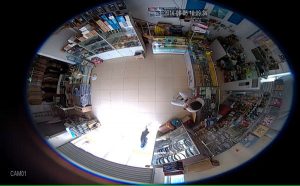
Single Sensor Panoramic Cameras
IP cameras that provide 360-degree views use special wide-angle lenses. We sometimes refer to them as fisheye lenses. I guess the lens looks like the bulging eye of a fish.
Unfortunately the wider the angle of the lens, the more distortion occurs. The barrel distortion makes straight lines bend.
The distortion can be corrected or de-warped using special software. The de-warping software can reside in the video management software (VMS that runs on your computer) or in the camera. For example, Immervision provides both a lens and algorithms that run in VMS. The company provides special Panamorph lenses and software that improves the quality of the video.
Single-sensor panoramic cameras are smaller than the multi-sensor panoramic cameras but have less resolution. The early fish-eye cameras did not have enough resolution to see the details of person’s face unless the person was very close to the camera. The latest single IP camera solutions use 4K cameras, with up to 12-Megapixel resolution.
Calculating Visual Distance for Single Sensor Panoramic IP Cameras
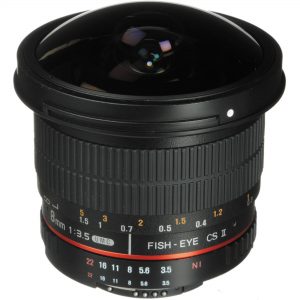
How far can you see? You can see the moon which is 238,900 miles (384,400 km) away. Of course, you cannot see too much detail at that distance. The effective distance of an IP camera depends on how large the object is and how much detail you would like to see. For example, if you would like to see all the craters on the moon you will need a powerful telescope.
In previous articles, we described the resolution required to detect, recognize or identify objects in the field of view of a standard camera with narrow lens.
For example, the article calculating “What You Can See WIth Your IP Camera,” described how to do the calculations. The article “What IP Cameras Resolution Do You Need?” defined the resolution required for identifying a person’s face or a license plate number. Calculating the viewing distance of a panoramic camera requires some different calculations.
The viewing distance is determined by the resolution of the camera and the lens angle (magnification). As an example, let’s assume that we need at least 80 pixels/ft. This resolution provides enough resolution to identify a person that we know. We require higher resolution to identify a person that we do not know, and even higher resolution when using facial recognition software.
When the angle of the camera lens is very wide, we use the formula for calculating the radius of a circle. The radius is the effective distance for identifying a person’s face.
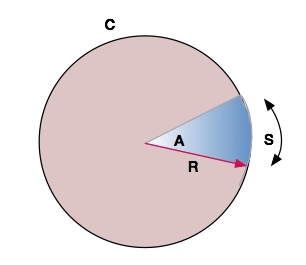
C= circumference
R = distance (or radius of the circle)
A= angle of the lens
R = distance (or radius of the circle)
S= The line segment that equals the field of view
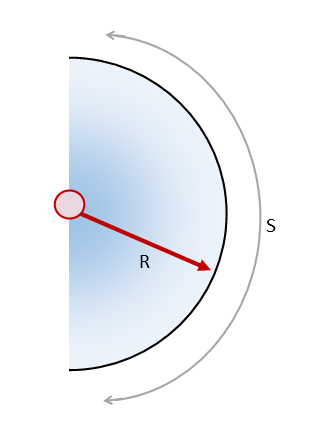
The panoramic camera has an 180-degree lens.
The field of view (S) is equal to the semicircle.
The length of the 180-degree segment is calculated by dividing the resolution of the camera by the pixels/ft required.
Let’s assume that we use a 4K camera like the PNF-9010 from Samsung Hanwha. The resolution of this camera is 4000 x 3000 pixels. Since the field of view is square for a panoramic camera, we use 3000 pixels for our calculations.
Field of View (FOV) = total pixels / Pixels/ft
- FOV = 3000/80 pixels/ft = 37.5 ft. (11.43 m)
Note that the field of view equals the 180-degree segment S
- S = 37.5 ft
so the total circumference is:
- C = 2 x S = 37.5 x 2 = 75 ft. (22.9 m)
Now we use the radius formula to calculate the distance:
R = C/(2π)
- R = 75 / 2 x 3.14 = 11.9 ft. (3.6 m)
So the calculations for the panoramic camera indicates that there is enough resolution to recognize a person that is less than 11.9 ft (3.6 m) away from the camera. Further away we see less detail. This camera is a good choice for situations where the area is small. It can also be used in larger areas where you just need situational awareness.
Note that the resolution of the panoramic camera varies from the center to the outer edge of the view. The resolution is best at the edge and worst in the middle.
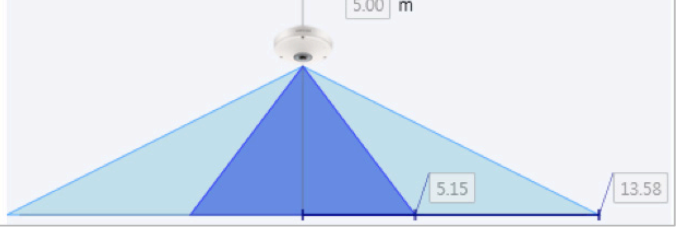
The dark blue area provides about half the resolution of the light blue area.
Multi-Sensor Panoramic Cameras
Multi-sensor (or camera) panoramic cameras are larger than the single-sensor camera but provide much more resolution. These panoramic IP cameras have a single network connection and are considered a single camera by the video recording systems. This means you only require a single camera license for the video recording software. The cameras (or sensors) are positioned so that the software can stitch the video together to create one large panoramic image. The camera direction can not be changed. They are available with the capability for 180-degree, or 360-degree view.
Arecont Vision introduced one of the first multi-camera panoramic cameras. These early cameras were large and had limited frame rate capability.
New panoramic cameras from Avigilon, Axis, Hanwha (Samsung) and Pelco provide much better resolution and performance. The new cameras can provide a single panoramic image or separate views (and video streams). The Hanwha PNM-9020V contains four 2-Megapixel cameras.
Calculating the Visual Distance for Multi-Sensor Panoramic Cameras
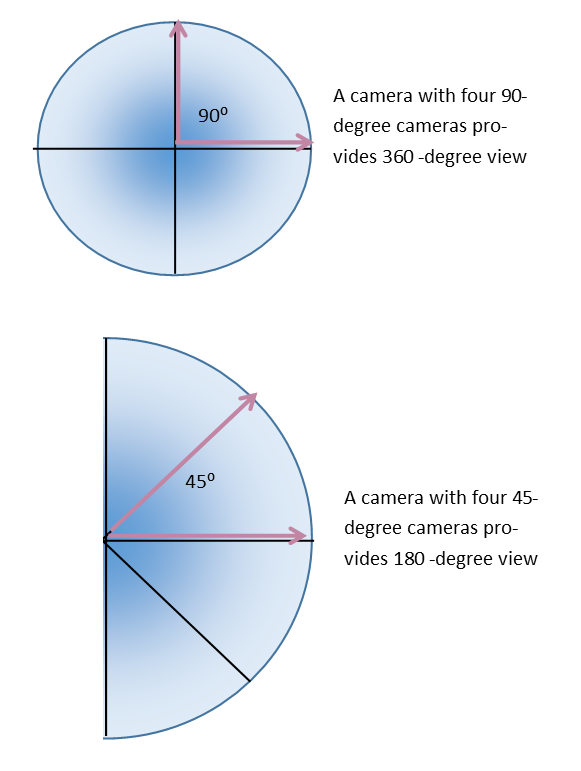
First, let’s note that there is a difference between 180-degree cameras and 360-degree cameras. The 180-degree panoramic camera, such as the Hanwha PNM-9020V IP camera, mounts on the wall. The 180-degree field of view provides twice the working distance when compared to the 360-degree view. The distance is greater because the 180-degree configuration uses 45-degree angle lenses, while the 360-degree view uses 90-degree lenses. The wider the view, the shorter the working distance.
To do the calculations, let’s assume we are using the Hanwha PNM-9020V panoramic camera that includes four 2-Megapixel cameras with 1920 x 1080 pixel resolution. We also assume that each sensor uses a 45-degree lens. This is an unusual camera in that it uses hall-way mode for each camera. Hallway mode rotates the view by 90-degrees providing a wider vertical view. This increases the vertical distance that can be viewed when the camera is placed on the wall.
It also means we must use the 1080 pixel resolution instead of the 1920 resolution to do the calculations.
- The field of view equals 1080 pixels / 80 Pixels/ft. = 13.5 ft. (4.1 m)
Each lens covers 1/8th of the circle.
- The circumference is equal to 8 X 13.5 ft. = 108 ft. (33 m)
Using the circle formula, C/(2π) = R
- R= 192 ft. / 6.28 = 17.2 ft. (5.2 m)
A 360-degree panoramic system that uses 2-Megapixel cameras mounts on the ceiling and provides a wider view of the room, including the area under the camera. Since it uses 90-degree lenses, the working distance is cut in half. R = 8.6 ft (2.6 m)
An advantage of the multi-sensor camera is improved resolution and less distortion. The resolution stays fairly uniform through the total image.
The disadvantage is that the cameras are larger than the single-sensor panoramic IP cameras.
Multi-Sensor, Multi-Directional Panoramic Cameras
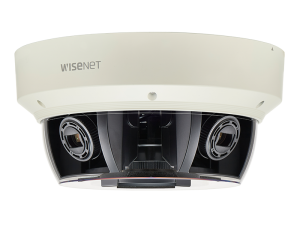
The latest cameras contain four or more high-resolution cameras (or sensors) that can be adjusted independently. These multi-direction cameras can be used in similar applications as the panoramic cameras. The difference is these cameras do not stitch all the views together like the panoramic cameras. Multi-directional IP cameras are available from Axis, and Hanwha (Samsung). For example, the Hanwha PNM-9081VQ IP camera contains four camera heads. This is a multi-sensor, and multi-directional camera system. Each camera can be separately adjusted, and remotely zoomed and focused.
Calculating the Visual Distance for Multi-Sensor, Multi-Directional Cameras
There are two models available from Hanwha, the PNM-9080 which uses 2-Megapixel cameras, and the PNM-9081 that uses 5-Megapixel cameras. The lenses of each camera can be set independently. If each of the 5-Megapixel camera lenses is set to a 90-degree view, we can calculate how far away we can identify a person.
- This camera has a resolution of 2560 x 1920.
- The field of view equals 2560 pixels / 80 Pixels/ft. = 32 ft. (9.8 m)
This is for ¼ of the circle instead of ½ the circle.
- The circumference is equal to 4 X 32ft. = 128 ft. (39m)
Using the circle formula, C/(2π) = R
- R= 128 ft. / 6.28 = 20 ft. (6 m)
The advantage is that the four cameras can be positioned independently providing higher resolution where you need it. A camera system that has individually positioned cameras is useful when you would like to observe specific regions of an area. For example, you can be viewing a large room and focus one of the cameras at a doorway where you would like to identify a person’s face as they enter. If the lens is set for to a narrower angle, the operating distance increases. For example, if you set the lens to 45-degrees, the range increases to about 41 ft. (12.5 m).
The disadvantage is that the camera is larger, and requires more power. For example, the PNM-9081VQ camera requires high power PoE injector (which comes with the camera at no extra charge).
Summary
Panoramic cameras provide a continuous 180-degree or 360-degree view of the surroundings. They are excellent for situational awareness because you can see everything in an area. The single camera panoramic cameras require special software to de-warp the video. Multi-sensor panoramic cameras provide higher resolution and provide enough resolution to identify a person’s face at a greater distance than the single cameras. The multi-directional IP cameras use multiple sensors, but don’t stitch all the views together.
We calculate viewing distance based on the resolution we need and the type of lens. The multi-sensor camera can view more detail, and allow you to identify a person’s face up to 20 ft (6 m) away, while the single sensor camera has a range of only about 11.9 ft. (3.66 m).
For help selecting the right IP panoramic camera, please contact us at 800-431-1658 in the USA, or at 914-944-3425 everywhere else, or use our contact form.